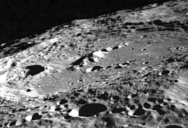New Study Proposes Sending Life To A Moon Vault To Help Protect Biodiversity On Earth

Life is fragile. While it is often talked about that a great number of plants and animals have gone extinct, or are in danger of going extinct, due to the actions (or inactions) of humans, life is dangerous even if humans aren’t around.
A huge number of different species have come into existence and then gone extinct on Earth over the millions of years before humans evolved.
While more should absolutely be done to minimize our impact on the environment, some scientists are looking at ways to protect biodiversity regardless of what might cause them to become extinct.
To do this, a team of scientists have published a study in the journal BioScience that identifies a way to preserve various species for the future. The idea is similar to the existing preserves where the necessary genetic material is kept frozen in vaults.
There are several of them around the world in locations that are away from civilization, naturally very cold, and have minimal earthquakes.
In the event of a mass extinction event, people (or whatever intelligent life forms again) will hopefully find these preserves and have the ability to clone the plants and animals back into existence.

This new paper suggests taking this concept to a whole new level. In fact, it wants to take it to the moon.
Dr. Mary Hagedorn of the Smithsonian’s National Zoo and Conservation Biology Institute proposes that this biological material be brought up to one (or more) of the large craters that exist at the poles of the moon.
These craters never see sunlight, and are therefore naturally cold enough to preserve the material for millennia.
The paper says that the temperatures remain below -196 degrees Celsius (-321 degrees Fahrenheit). Maintaining these temperatures without any outside intervention is essential for protecting this type of vault long into the future.
Of course, it won’t be cheap or easy to complete this type of effort. Dr. Hagedorn is working to bring scientists, governments, and space agencies together to move this concept forward so that life can be better protected.

The best way to preserve biodiversity may be to send it to the moon.
It shouldn’t be a surprise, really.
If you thought that was interesting, you might like to read about why we should be worried about the leak in the bottom of the ocean.

Sign up to get our BEST stories of the week straight to your inbox.




